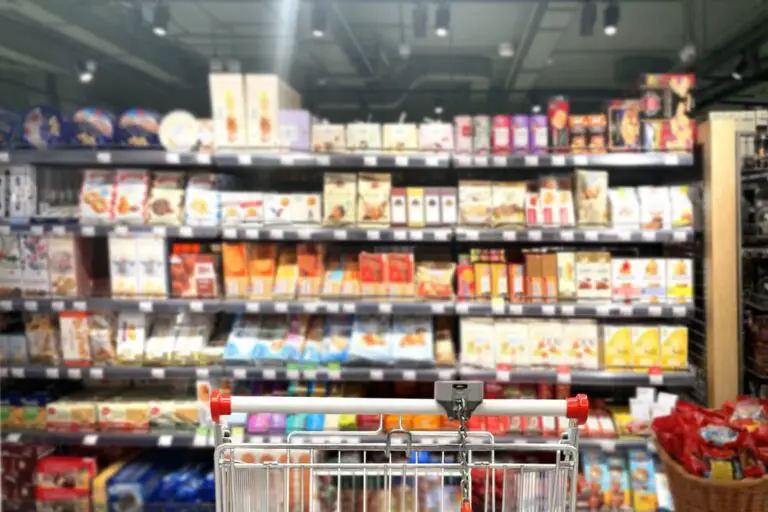Trade show marketing strategies remains a critical component of a company’s overall marketing strategy. With 93% of trade show attendees considering these events vital to their purchasing journey (CEIR, 2023) and 91% gaining crucial buying insights, it’s clear that trade shows offer unique opportunities for businesses to connect with their target audience and drive sales.
Key Takeaways
- Develop a comprehensive pre-show, during-show, and post-show strategy
- Create an engaging booth design that attracts and retains visitors
- Utilize social media and event technology to enhance attendee engagement
- Implement a robust lead capture and follow-up system to maximize ROI
- Measure and analyze key metrics to refine future trade show strategies
Introduction to Trade Show Marketing
Trade shows have evolved to keep pace with the digital landscape, but their importance in driving business growth remains constant.
According to the Center for Exhibition Industry Research (CEIR), trade shows contribute an estimated $101 billion to the U.S. GDP annually.
Moreover, 46% of executive decision-makers make purchase decisions while attending trade shows, and 77% find at least one new supplier during their visit (Exhibit Surveys, 2022).
Pre-Show Planning Strategies
Effective trade show marketing begins with meticulous pre-show planning. Start by setting clear goals and key performance indicators (KPIs) that align with your overall business objectives.
Conduct thorough audience research to understand attendee demographics, preferences, and pain points, which will inform your booth design, promotional materials, and engagement strategies.
Step-by-Step Guide: Setting Trade Show KPIs
- Identify your primary trade show objective (e.g., lead generation, brand awareness, product launch)
- Define specific, measurable targets (e.g., collect 100 qualified leads, achieve a 20% increase in social media followers)
- Assign KPIs to each goal (e.g., number of booth visitors, social media engagement rate)
- Establish tracking mechanisms and reporting frequency
- Communicate KPIs to your team and stakeholders
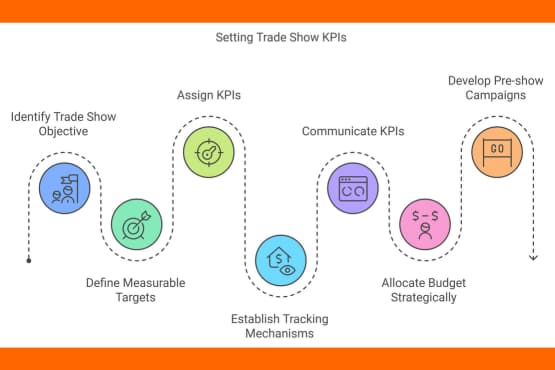
Allocate your budget strategically, prioritizing elements that directly contribute to your goals, such as booth design, promotional giveaways, and lead capture technology.
Develop targeted pre-show email campaigns to build anticipation and encourage attendees to visit your booth.
Engaging Booth Design
Your trade show booth is the centerpiece of your on-site presence and should be designed to attract, engage, and educate attendees.
Incorporate eye-catching visuals, clear branding, and intuitive layouts that encourage exploration. Consider investing in modular and reusable booth components to maximize sustainability and cost-effectiveness across multiple events.
PolyJohn, a leading portable restroom provider, successfully attracted visitors to their booth at the WWETT Show by adopting a unique “PolyPalooza” music festival theme.
Their creative approach, which included engaging booth designs and enticing giveaways like band-inspired T-shirts and guitars, generated over 500 leads and numerous compliments from attendees.
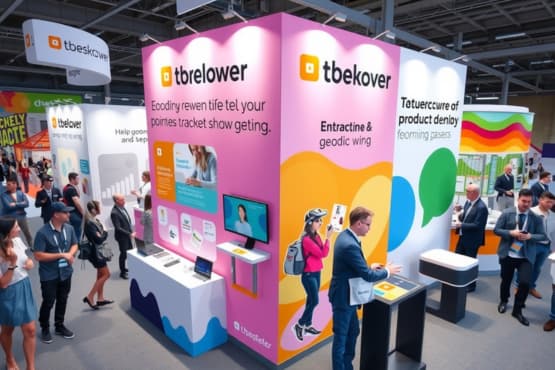
Expert Insights
“An effective trade show booth should tell a compelling story, evoke emotions, and create a memorable experience for attendees. Incorporating interactive elements, such as virtual reality demos or gamification, can significantly increase engagement and lead generation.” – Sarah Thompson, VP of Marketing at EventGeek
“When designing your trade show booth, prioritize simplicity, clarity, and interactivity. Use bold graphics, concise messaging, and hands-on product demos to captivate attendees and differentiate your brand from competitors.” – Michael Rodriguez, Senior Exhibition Designer at Skyline Exhibits
Promotional Materials and Giveaways
Promotional materials and giveaways are essential for attracting attendees to your booth and creating a lasting impression.
Choose items that are practical, relevant to your target audience, and aligned with your brand identity.
Consider sustainable options to resonate with environmentally conscious attendees and showcase your company’s commitment to corporate social responsibility.

FAQ: What is the average cost of promotional giveaways?
The cost of promotional giveaways varies depending on the item, quantity, and customization.
According to a recent ASI survey, the average cost per promotional item is $1.05, with the most popular items being pens, bags, and t-shirts.
However, investing in higher-quality, unique items can lead to better brand recall and ROI.
On-Site Engagement Techniques
Engaging attendees at your booth is crucial for generating leads and creating memorable interactions.
Incorporate live demonstrations, interactive workshops, and hands-on experiences that allow attendees to explore your products or services firsthand.
Leverage event apps and augmented reality (AR) to create immersive experiences that educate and entertain.
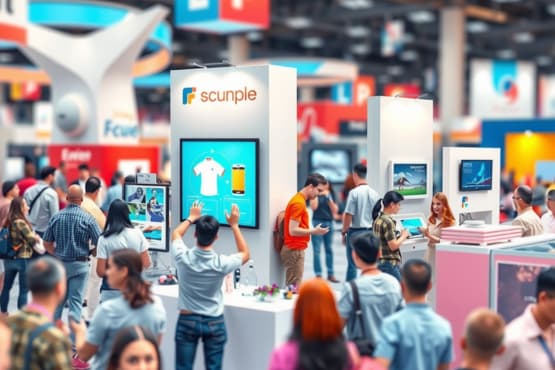
Emerging Trend: AI-Powered Attendee Analysis
Utilizing AI-powered tools to analyze attendee behavior and preferences can help you tailor your on-site engagement strategies in real-time.
For example, Zenus, an AI-powered facial recognition platform, enables event organizers to track attendee movement, measure engagement, and optimize booth staffing based on real-time data insights.
Leveraging Social Media Before and During the Event
Social media plays a vital role in amplifying your trade show presence and engaging attendees throughout the event lifecycle. Develop a comprehensive social media strategy that includes platform-specific tactics, user-generated content (UGC) campaigns, and unique hashtags to expand your reach and build buzz.
Lead Capture and Follow-Up Systems
Implementing an effective lead capture and follow-up system is essential for converting trade show interactions into tangible business opportunities.
Utilize modern lead capture technologies, such as QR codes or badge scanners, to streamline data collection while ensuring compliance with data privacy regulations like GDPR and CCPA.
Integrate your lead capture system with your customer relationship management (CRM) platform to enable prompt and personalized follow-up. Develop a visual flowchart that outlines your lead nurturing process, including targeted email campaigns, personalized offers, and sales team outreach.
Measuring Trade Show ROI
Measuring and analyzing your trade show ROI is crucial for refining your strategies and maximizing your investment. Key metrics to track include booth traffic, lead quantity and quality, engagement rate, and cost per lead.
The basic formula for calculating trade show ROI is: (Revenue – Cost) / Cost x 100%.
For example, if your company spends $20,000 on a trade show and generates $100,000 in revenue, your ROI would be: ($100,000 – $20,000) / $20,000 x 100 = 400%
According to industry benchmarks, the average company allocates approximately 31.6% of its total marketing budget to events and exhibiting (Exhibitor Magazine, 2023).
While 5% to 10% of trade show leads typically convert into sales, some Fortune 500 companies report achieving an impressive 5:1 ROI, generating $5 for every $1 spent on trade shows (CEIR, 2022).
Post-Show Analysis and Strategy Refinement
Conducting a thorough post-show analysis is essential for identifying areas of improvement and refining your strategies for future events.
Collect attendee feedback through surveys and follow-up communications to gain valuable insights into their experience, preferences, and pain points.
Analyze your performance relative to competitors by evaluating their booth designs, promotional strategies, and attendee engagement tactics.
Use this competitive intelligence to identify best practices and differentiate your approach in future events.
Lawpilot, a legal tech startup, exemplifies the importance of a comprehensive post-show analysis.
By implementing a data-driven marketing strategy that focused on branding, storytelling, and eye-catching booth designs, Lawpilot increased their leads by up to 2000% at a recent trade show.
Their approach not only captured leads effectively but also established a strong brand presence within the immigration lawyer community.

Lawpilot’s Success Strategies
- Developed a cohesive brand narrative that resonated with their target audience
- Invested in eye-catching booth designs featuring continuous product demos
- Leveraged social media and email marketing to drive booth traffic
- Implemented a streamlined lead capture and follow-up process
- Conducted a thorough post-show analysis to refine future strategies
Emerging Trends in Trade Show Marketing
As the trade show landscape continues to evolve, staying ahead of emerging trends is crucial for maintaining a competitive edge. Some key trends to watch include:
1. Metaverse Trade Shows
The rise of virtual reality (VR) and augmented reality (AR) has paved the way for immersive, interactive trade show experiences within the metaverse.
By creating virtual exhibit halls, product demonstrations, and networking opportunities, companies can extend their reach beyond physical limitations and engage with a global audience.
To implement a metaverse trade show strategy, consider partnering with a VR platform provider, such as VirBELA or Spatial, to develop a customized virtual environment that reflects your brand identity and showcases your products or services.
Incorporate gamification elements, such as virtual scavenger hunts or leaderboards, to incentivize attendee participation and drive engagement.
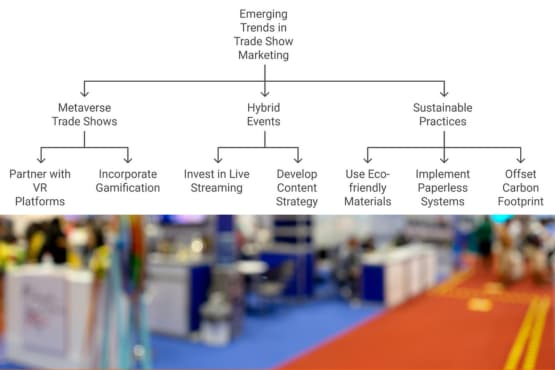
2. Hybrid Events
Hybrid events, which combine in-person and virtual elements, have gained popularity in the wake of the COVID-19 pandemic.
By offering a hybrid format, trade show organizers can expand their audience reach, improve accessibility, and provide a more flexible attendee experience.
To successfully execute a hybrid trade show strategy, invest in reliable live streaming technology, such as Zoom or Hopin, to ensure seamless connectivity between in-person and virtual attendees.
Develop a comprehensive content strategy that caters to both audiences, incorporating live demos, panel discussions, and interactive Q&A sessions.
| Platform | Features | Pricing |
|---|---|---|
| Zoom | HD video, breakout rooms, screen sharing | $149.90/year/license |
| Hopin | Virtual venue, networking, analytics | $99/month/organizer |
| Bizzabo | Event app, live streaming, networking | Custom pricing |
| Cvent | Registration, live streaming, lead capture | Custom pricing |
Comparison of popular hybrid event platforms
3. Sustainable Practices
As environmental concerns continue to grow, implementing sustainable practices in trade show marketing is becoming increasingly important.
By adopting eco-friendly strategies, companies can demonstrate their commitment to corporate social responsibility and appeal to environmentally conscious attendees.
To incorporate sustainable practices into your trade show strategy, consider using recyclable or biodegradable booth materials, implementing paperless lead capture systems, and offsetting your carbon footprint through renewable energy credits or reforestation programs.
Conclusion:
Incorporating proven trade show marketing strategies is essential for driving ROI and achieving your business objectives. By setting clear goals, designing an engaging booth, leveraging social media, and implementing a robust lead capture and follow-up system, you can maximize the impact of your trade show presence.
As the trade show landscape continues to evolve, embracing emerging trends like metaverse experiences, hybrid events, and sustainable practices will help you stay ahead of the curve and deliver exceptional value to your target audience.
By continuously refining your strategies based on data-driven insights and attendee feedback, your company can achieve long-term trade show success and drive meaningful business growth.




